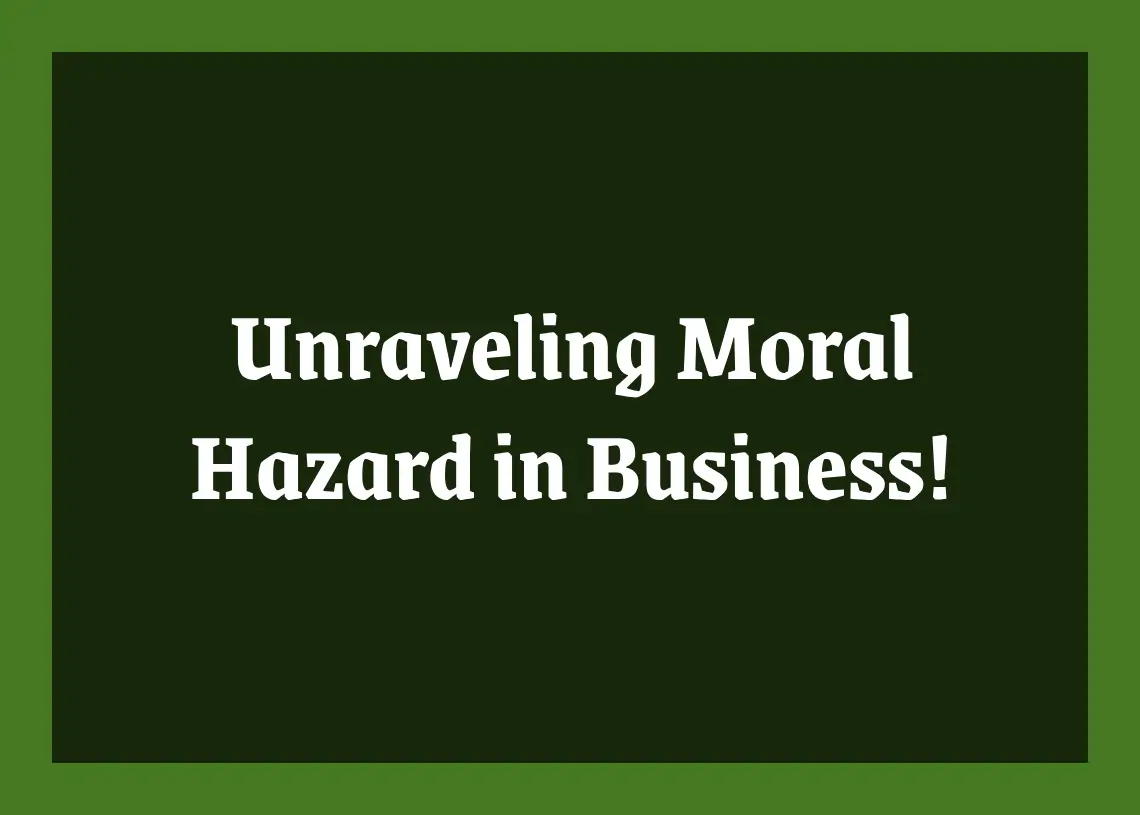As businesses continue to grow and evolve, moral hazard becomes an increasingly important concept to understand. This term refers to the tendency for individuals or organizations to take excessive risks because they do not bear the full cost of their actions.
This can have serious consequences for both the company and the wider economy, as we have seen in recent financial crises. In order to prevent or mitigate these risks, it is essential that business leaders and policymakers understand the causes and effects of moral hazard, and take steps to address it.
In this blog post, we will explore the concept of moral hazard in business, and delve into some of the key factors that contribute to this phenomenon. We will examine the role of incentives, both positive and negative, and the ways in which they can influence behavior.
We will also consider the impact of government policies and regulations, and how they can either exacerbate or mitigate moral hazard. Finally, we will explore some of the potential solutions for addressing this issue, including increased transparency and accountability, and the implementation of stronger regulations and penalties for unethical behavior.
Earn a certificate in your dream career for an affordable price at IAP Career College today!
Moral hazard and its definition
Moral hazard is a term widely used in the field of economics, finance, and insurance to describe a situation where an individual or an organization is incentivized to take risks that they would otherwise not take. This arises when one party is insulated from the consequences of their actions, knowing that the costs or losses will be borne by others.
In simple terms, moral hazard refers to a scenario where a person or a business is willing to take on more risk because they do not have to bear the full consequences of their actions. This phenomenon can lead to adverse outcomes, such as reckless behavior, fraud, and increased costs for insurers and taxpayers. It is important for businesses and policymakers to understand the concept of moral hazard and its potential impact on decision-making in order to mitigate the risks associated with it.
Causes of moral hazard
Moral hazard is a term commonly used in the field of economics and finance to describe the risk-taking behavior that can occur when people are protected from the negative consequences of their actions. There are many factors that can contribute to the emergence of moral hazard in business, but two of the most common causes are asymmetric information and the presence of insurance or other forms of protection.
Asymmetric information occurs when one party in a transaction has more information than the other, which can lead to misaligned incentives and risky behavior. Insurance and other forms of protection can also create moral hazard by reducing the consequences of risky behavior, which can encourage people to take more risks than they would otherwise.
Understanding these and other causes of moral hazard is critical for businesses looking to mitigate their risks and ensure ethical behavior among their employees.
Effects of moral hazard
Moral hazard is a term used to describe a situation where one party has an incentive to take risks because they are protected from the consequences of their actions. It is a phenomenon that can be observed in various contexts, including business and finance.
One of the most significant effects of moral hazard is that it can lead to increased risk-taking behavior, which can result in adverse outcomes. For instance, in the business world, moral hazard can lead to reckless decision-making, as managers or employees may take on risky projects or engage in unethical behavior, knowing that they will not be held responsible for the consequences.
This can have severe repercussions on a company’s reputation, financial performance, and overall success. Additionally, moral hazard can lead to an uneven distribution of rewards and risks, as those who engage in risky behavior may reap the benefits while others bear the costs. Therefore, understanding the effects of moral hazard is essential for businesses to mitigate its negative impact and promote responsible decision-making.
Moral hazard in the workplace
Individuals or organizations may act recklessly or irresponsibly in situations where they are not held fully accountable for their actions. This behavior is called moral hazard in the workplace. It can occur when individuals are protected from the full consequences of their actions, such as when they are insured or when they receive government bailouts.
In the business world, moral hazard can manifest in a variety of ways, such as when managers take excessive risks with company resources, knowing that they will not bear the full brunt of any negative outcomes. Understanding and identifying moral hazard in the workplace is crucial for organizations to mitigate risk and ensure responsible behavior.
How to identify moral hazard
Identifying moral hazard is a crucial skill that every business leader should possess. Moral hazard refers to the phenomenon where one party takes risks knowing that the costs or consequences of those risks will be borne by another party.
This can lead to a lack of accountability and irresponsible behavior. To identify moral hazard in your business, it is important to look for signs of excessive risk-taking, such as careless decision-making, ignoring best practices, and reckless behavior.
Additionally, you should examine the incentives in place that may lead to moral hazard, such as performance-based compensation or a lack of consequences for poor outcomes. By understanding and identifying moral hazard in your business, you can take steps to mitigate its impact and promote responsible decision-making and accountability.
The importance of prevention
Individuals have a tendency to take risks that they would not normally take if they were fully exposed to the consequences of their actions, a well-known concept in business and economics called moral hazard. For example, in the context of insurance, insured individuals tend to take greater risks because they know they are protected against the financial consequences of those risks.
This can lead to adverse selection and higher costs for insurance companies. In order to mitigate the effects of moral hazard, it is important to focus on prevention rather than just on remediation. By encouraging individuals and organizations to take steps to prevent losses from occurring in the first place, we can reduce the incidence of risky behavior and improve overall outcomes.
This requires a proactive approach to risk management, which involves identifying potential risks and taking steps to mitigate them before they become significant problems. By emphasizing prevention, we can create a culture of safety and responsibility that benefits everyone involved.
Strategies to mitigate risk
Moral hazard is a term used to describe the behavior of individuals who take excessive risks due to the fact that they are protected from the consequences of their actions. In the context of business, it can refer to executives who take risky actions that benefit themselves personally, but not the company as a whole.
To address this problem, businesses can employ strategies to mitigate the risk of moral hazard. One approach is to establish clear expectations and incentives for ethical behavior at all levels of the organization. Another strategy is to ensure that decision-making processes are transparent and involve multiple stakeholders to ensure accountability.
Additionally, businesses can implement risk management systems that identify and address potential hazards before they become problematic. By implementing these strategies, businesses can reduce the potential for moral hazard and create a more responsible and sustainable corporate culture.
Creating a culture of accountability
Creating a culture of accountability is crucial in mitigating moral hazard in business. By fostering a sense of responsibility and ownership among employees, businesses can prevent individuals from taking actions that prioritize personal gain over the company’s best interests.
This can be achieved through various methods, such as setting clear expectations for performance and behavior, providing regular feedback and evaluations, and holding individuals accountable for their actions. Additionally, leaders should model accountability behavior themselves, leading by example and demonstrating their own commitment to ethical decision-making.
By creating a culture of accountability, businesses can reduce the risk of moral hazard and build trust among stakeholders, ultimately leading to long-term success and sustainability.
The role of leadership
In the business world, moral hazard is a term used to describe situations where individuals or organizations are incentivized to take on unnecessary risks due to a lack of consequences for negative outcomes. One of the most crucial components to mitigating moral hazard is strong leadership.
Leaders who prioritize ethical behavior and hold themselves and their teams accountable for their actions can create a culture of responsibility and trust. This culture can reduce the likelihood of moral hazard by encouraging individuals to consider the long-term consequences of their decisions and actions.
Effective leaders must also be transparent and communicate clearly to ensure that everyone in the organization understands the expectations for ethical behavior. By taking an active role in promoting ethical behavior, leaders can help prevent moral hazard and create a more sustainable and successful business.
The benefits of ethical behavior
In the world of business, individuals or organizations tend to take more risks when they are insulated from the consequences of their actions. We refer to this tendency as “moral hazard”. In other words, when people or companies are not held accountable for the negative outcomes of their decisions, they are more likely to engage in unethical or risky behavior.
However, ethical behavior can mitigate the effects of moral hazard in the workplace. By acting with integrity and adhering to a set of ethical principles, individuals and organizations can create a culture of trust and accountability that promotes responsible decision-making.
The benefits of ethical behavior include improved customer loyalty, increased employee satisfaction, and enhanced reputation in the marketplace, all of which can ultimately lead to long-term success and sustainability for a business.
Conclusion: Unraveling Moral Hazard in Business!
In conclusion, understanding and mitigating moral hazard in business is crucial for maintaining a healthy and sustainable economy. By implementing proper risk management practices, companies can avoid moral hazard and promote responsible decision-making.
It is important for businesses to prioritize long-term success over short-term gains and to hold individuals accountable for their actions. Through a commitment to ethical leadership, transparency, and accountability, businesses can build trust with stakeholders and contribute to a thriving and prosperous economy for all.





